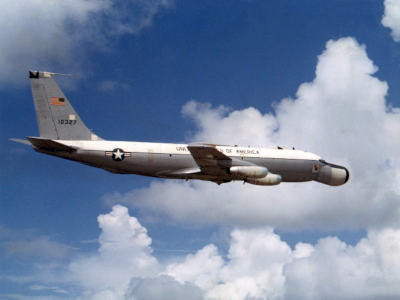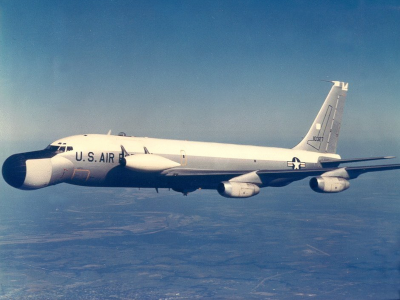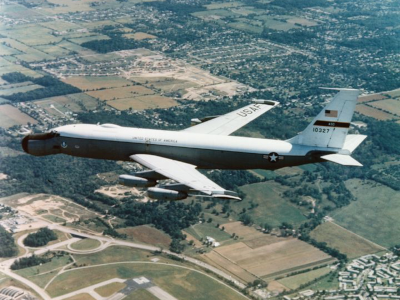


Aircraft 61-0327
The support requirements for Apollo, compiled by NASA's Office of Manned Space Flight (OMSF), originally stated a need for twelve heavily instrumented, long-range, high-speed aircraft to supplement the telemetry and communication support to be provided by the Apollo ships. After program refinement that the aircraft requirement would be eight, six to be on station with two standby spares. 61-0327 was one of the original eight Apollo Range Instrumentation Aircraft stationed out of Patrick Air Force Base, Florida. After serving with ARIA, aircraft 61-0327 served as a command aircraft.
The EC-135N that was on display at the Museum of Aviation was the command aircraft for General Norman Schwarzkopf and Tommy Franks during their tours as Commanders of the United States Central Command (USCENTCOM). General Schwarzkopf was commander of USCENTCOM and commander of Coalition Forces in the Gulf War of 1991. General Franks led USCENTCOM during the 2003 invasion of Iraq and the overthrow of Saddam Hussein.
Aircraft of this type began service as Airborne Command Posts (ABCP) with the Strategic Air Command (SAC) during the early years of the Cold War. The idea was for specially-equipped aircraft to be airborne at all times, 24 hours a day, seven days a week, 365 days a year, if SAC's underground command center was destroyed or disabled. This airborne command center also provided an alternate method of launching Minuteman/Peacekeeper missiles if ground launch control centers were damaged. Initially, 17 KC-135B tankers adapted for the ABCP's mission with flights beginning on February 3, 1961. The new aircraft dubbed the Stratolifter because its role mirrored ground-based command, control, and communications, operations, and by 1964 formally designated EC-135. The EC-135 fleet, equipped with comprehensive high-tech communications equipment, allowed the airborne commander to link with national command authorities, theatre forces, with other airborne command posts and with his assets on the ground. The flight crew of an EC-135 consisted of two pilots, a navigator, an airborne refueling system operator, and communication system operators. For 29 years, EC-135s conducted continuous airborne operations, accumulating more than 281,000 accident-free flying hours – an aviation phenomenon. On July 24, 1990, SAC ceased constant airborne alert but kept EC-135s on ground alert 24 hours a day. On October 1, 1998, the EC-135 aircraft was formally retired from the Air Force, and its airborne mission transferred to a new platform – the Navy' #-6B aircraft.
The EC-135 service to the Commander in Chief, USCENTCOM, began at Robins AFB, GA in 1984 with one aircraft. EC-135N Aircraft 61-0327 started its service at Robins AFB in 1987, assigned to the 19th Air Refueling (H) Wing. During its tenure at Robins, EC-135 aircrews and maintenance personnel provided mission support to the Commanders of USCENTCOM and the forces in Africa, the Middle East, and the Central Asian Region. Often, crews operated in extreme conditions where aircraft ramp temperatures reached over 145 degrees Fahrenheit. Aircraft 61-0327 on display at the Museum of Aviation, was the last aircraft to carry the designation of EC-135N and was delivered to the 1611th Air Transport Wing (Military Air Transport Service), McGuire AFB, New Jersey on November 29, 1961. In 1966 the aircraft transferred to the Eastern Test Range, Air Force Systems Command (AFSC), Patrick AFB, Florida, converted to an EC-135N model. From 1975 until 1987, 61-0327 was flown by the 4950th Test Wing (AFSC), Wright-Patterson AFB, Ohio, before being transferred to the 19th Air Refueling Wing (SAC) at Robins AFB, Georgia. With more than 20,000 flying hours, this aircraft was retired in 2003. It was moved to the Museum of Aviation for display on March 2, 2006.
1961
Constructed C-135A-BN. Construction Number 18234.
1966
Conversion to EC-135N with electrical and structural modifications at Douglas Aircraft, Tulsa, Oklahoma.
September 28, 1967
Aircraft arrived at Patrick Air Force Base, Florida.
January 1, 1968
Aircraft Online and operational as an Apollo Range Instrumentation Aircraft.
December 1975
Transferred to Wright-Patterson Air Force Base, Ohio, 4950th Test Wing, operational as an Advanced Range Instrumentation Aircraft.
June 30, 1985
Last Inventory Record WPAFB.
1987
Aircraft transferred to the 19th Air Refueling Wing (SAC) Robins Air Force Base, Warner Robins, Georgia. Airborne Command Post.
March 2, 2006
Retired, Museum of Aviation Robins Air Force Base, Warner Robins, Georgia.
2015
Aircraft scheduled for scrapping.
Credit: Randy L. Losey